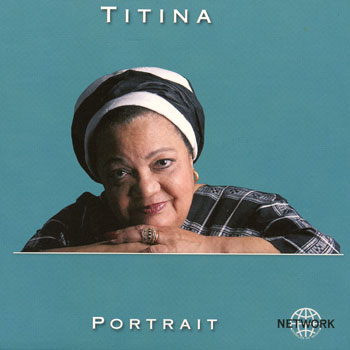Reviews August 8, 2012
Portrait
Titina is the “other” venerable diva of the Cape Verdean archipelago. Like the singer in whose shadow she has lived and labored—Cesaria Evora—Titina was born in Mindelo, capital of the island of São Vicente. Titina’s parents adored and sang the signature Cape Verdean morna, a doleful song form that captures the complex emotions of an island people, immigrants and emigrants, constantly dealing with the pain of separation from beloved people and places. Her parents also loved Brazilian music, and the festive Cape Verdean genre, coladeira. (Those two genres comprise most of Titina’s work, it seems.) Like Cesaria, Titina grew up amid neighbors and friends that included key Cape Verdean composers including B. Leza and Jorge Monteiro. Impressed by Titina’s voice, which they could hear on the national radio, these composers sought her out and asked her to sing their songs.
In recent decades, of course, Cesaria got the big international breaks and polished her sound significantly. What we get on these 13 Titina tracks is a window into an older world of Cape Verdean music, pre-Paris. The first 7 tracks come from relatively recent recordings made for the Cape Verdean market; the last 6 go back as far as the early ‘60s. So to hear this rich collection is to travel through time.
The mature Titina has a gorgeous voice, with relaxed luster, clarity and transparent emotions worthy of Cesaria. On B. Leza’s morna “Terra Longe,” Titina’s husky, resonant lead is backed by an orchestra, with clarinet prominent, and a choir, used sparingly but adding tremendous warmth to the mix. Her pacing is impeccable as she maps the woeful path of a broken heart longing, in this case, for distant São Vicente. “Catatau” is a frisky coladeira in which Titina—half speaking, half singing—assumes the character of a woman who threatens her cheating man with “a good beating.” Love affairs, cursed by distance and suspicion, account for many of these lyrics, sometime playful and sometimes disconsolate. The coladeira-morna dynamic, festivity and lament, is at play throughout, and the balance is right. Listening to these performances, one does wonder why it has taken so long for us to hear this remarkable artist.
The older tracks offer a fascinating look still further back. In the earliest tracks, Titina’s voice is thinner, less developed, and less well recorded—but still impressive. On “Stanhadina,” recorded in 1960, the band—already featuring prominent clarinet—channels a bit of samba and jazz. Titina sings a forthright boastful challenge to another young girl, shadowed by the clarinet. “Meninha D’Salamasa” is a more traditional coladeira, but interpreted here with a strong nod to the Dixieland sound. In the collection’s final morna, “Sodade Di Bô” (1983),” we hear the emergence of a star, tapping into that uniquely Cape Verdean strain of nostalgia (sodade) with emotional depth and expressive subtlety, and what sounds like a banjo worked into the quirky mix.
This is the afropop hybridism of an earlier age—innocent, sincere, refreshing, timeless.









